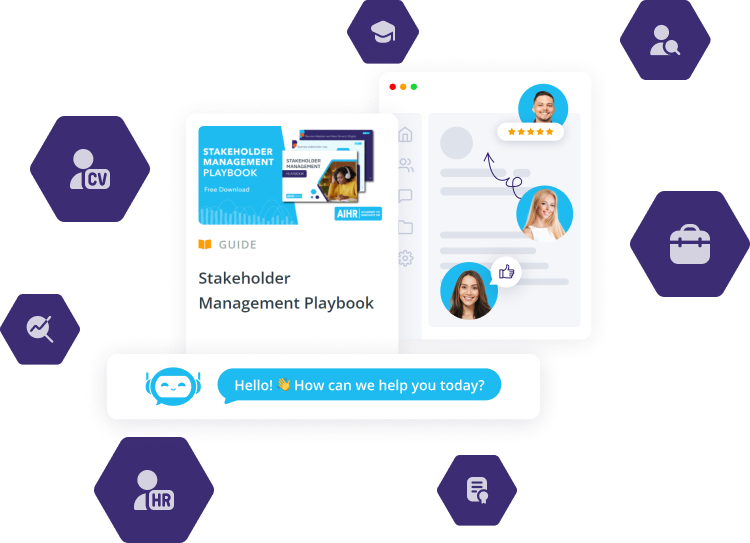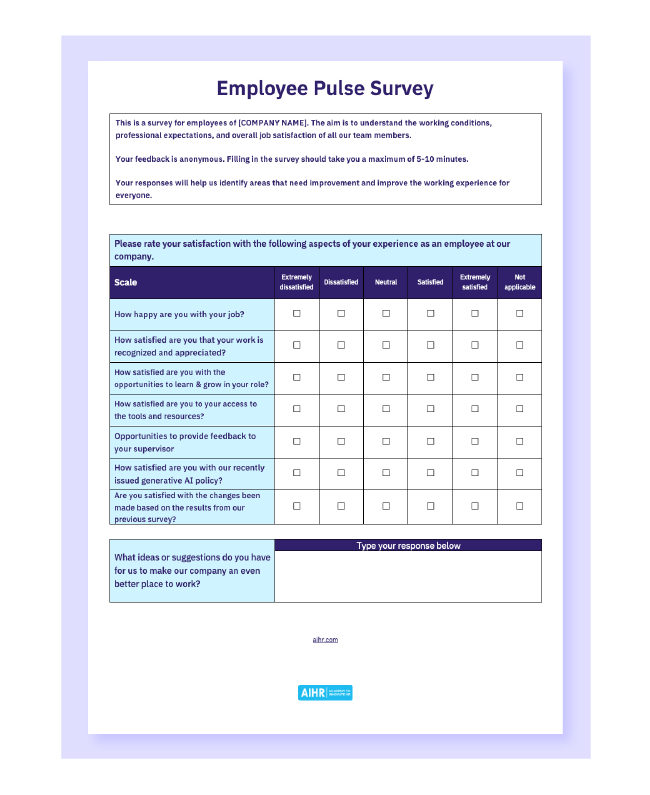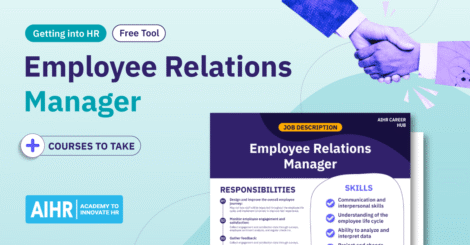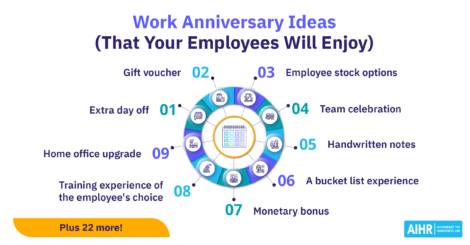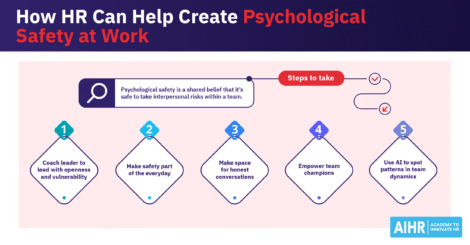An employee pulse survey is a great way for HR to stay on top of how employees are feeling. According to research by Qualtrics, 77% of employees want to provide feedback more frequently than once a year. Pulse surveys allow employees to do just that, while also helping organizations to quickly address any concerns.
In this article, we’ll dive into the employee pulse survey – exploring its purpose, benefits, and best practices, and even provide examples of pulse survey questions. Plus, we have a free employee pulse survey template available for you to use.
Let’s get started!
Contents
What is an employee pulse survey?
7 benefits of employee pulse surveys
The structure of an employee pulse survey
Employee pulse survey best practices
11 Employee pulse survey questions
Free employee pulse survey example
Employee pulse survey tools
What is an employee pulse survey?
An employee pulse survey is a brief questionnaire that is regularly sent out to employees, typically on a weekly, monthly, or quarterly basis. Its purpose is to gauge employee satisfaction, engagement, job roles, and work environment. By involving employees in the survey process, HR can gain valuable insights to improve the overall workplace experience.
What is the purpose of an employee pulse survey?
The main purpose of conducting an employee pulse survey may differ among organizations, but it typically revolves around one or more of the following aspects:
Monitoring employee satisfaction and morale
One effective way to gauge employee satisfaction and morale is by asking a few simple questions. This can provide insights into how employees feel about their work and the organization.
Identifying and addressing issues early on
Conducting a pulse survey allows for early detection of potential issues, such as a dip in morale or specific problems within a department.
Making informed decisions
Involving employees in the organization’s decision-making has proven to be beneficial for morale, engagement, and innovation, as highlighted by Deloitte’s Global Human Capital Trends survey.
By conducting an employee pulse survey, you can gauge people’s opinions on various aspects, such as new initiatives or upcoming policy changes, fostering engagement and encouraging active participation.
Improving employer-employee communication
Communication in the workplace is often a point of concern for employees. According to the Forbes Advisor State of Workplace Communication report, over 40% of workers say poor communication affects their trust in leadership. If used correctly, pulse surveys can contribute to better employer-employee communication.
HR tip
Culture Amp CEO Didier Elzinga explains: “The most typical reason people don’t want to fill out your survey is that you haven’t done anything since the last one. They don’t have survey fatigue; they have lack-of-action fatigue.”
Employee pulse survey vs. employee survey
Employee pulse surveys and ‘regular’ employee surveys are often used interchangeably, but they do have distinct characteristics. Let’s explore the key differences between the two to better understand their purpose and benefits:
- Frequency: The biggest difference between the two is the frequency with which they are conducted. A traditional employee survey tends to be sent out once or twice a year, whereas a pulse survey is done quarterly, monthly, or even weekly.
- Length: An employee pulse survey is short; the general rule of thumb is that the more frequent the survey, the shorter it should be. For instance, a monthly survey consists of around 10 to 15 questions.
- Topic: As pulse surveys are shorter, they can focus on one specific topic, such as an upcoming policy change, employee satisfaction, or communication. An annual survey covers various topics, including engagement, company culture, personal growth, employee experience, and satisfaction.
- Actionability: A pulse survey can provide more immediate and actionable insights for organizations to make quick changes and improvements. Conversely, a traditional employee survey gives a more comprehensive picture of the state of employee engagement in a company, thus informing more long-term strategies and initiatives.
7 benefits of employee pulse surveys
Conducting an employee pulse survey can benefit your organization in various ways:
- It shows you care. Regularly asking employees for their opinion on things – and then acting on it – shows them that the company values them and their input.
- Early identification of issues. Rather than getting information about why an employee is leaving during the exit interview, a pulse survey enables organizations to identify and address potential deal-breakers early on.
- Change analysis. During periods of organizational change, pulse surveys can be helpful tools to keep track of employee sentiment regarding those changes.
- Encourages communication. When employees are encouraged to give their opinions, for example, through pulse surveys, they are more likely to feel comfortable sharing with their peers, managers, and HR.
- A better feedback loop. With a pulse survey, you can create a positive feedback loop. As honest feedback comes in regularly, HR teams can fine-tune processes and policies and effectively meet the needs and expectations of their workforce.
- Quick and easy. Pulse surveys are short and don’t take up much of your employees’ time while at the same time (if you ask the right questions) still providing you with actionable insights.
- Good for engagement. All of these things combined naturally lead to a boost in employee engagement.
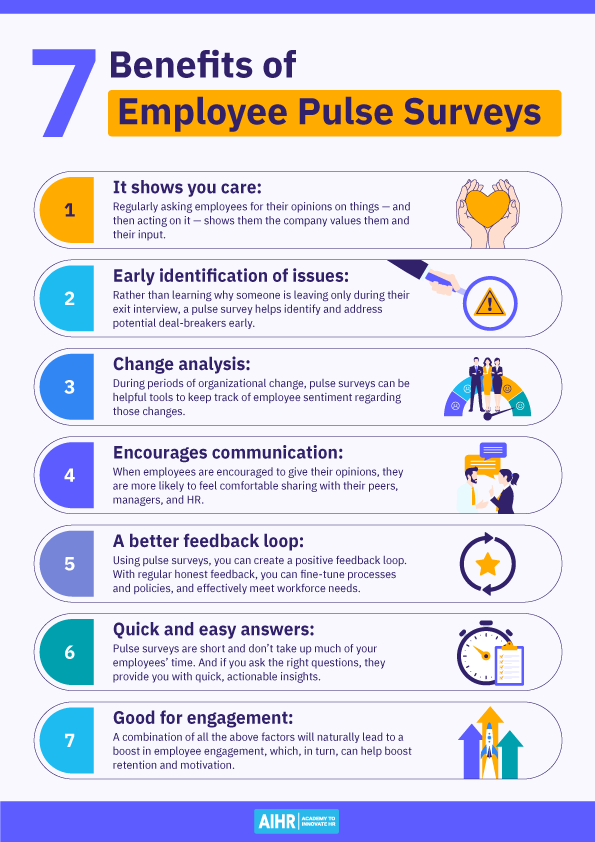
The structure of an employee pulse survey
Let’s take a closer look at what a pulse survey ideally looks like in terms of the types of questions to ask, the rating scale, length, etc.
Introduction
Provide a brief background on the purpose of the employee pulse survey. Let participants know how much time it will take to complete.
Engagement and satisfaction
Include 1 or 2 questions to measure overall engagement and satisfaction within the company. A 1 to 5 rating scale is often used for this type of question.
Work experience
Ask 3 to 5 questions about key aspects of the employee experience, such as manager relationships, job satisfaction, collaboration, and resources. Rating scales can be used here as well.
Priorities and initiatives
Include 1 or 2 questions about current organizational priorities, such as strategy rollouts, new policies, or initiatives.
Previous survey
Add 1 or 2 questions about the actions taken based on feedback from the previous pulse survey.
Demographics
Include 1 or 2 questions on department, location, tenure, or similar background details.
Open-ended feedback
End with an open-ended question such as, “What do you like most about working here?” or “What suggestions do you have for improvement?”
Closing
Thank employees for participating and let them know when and where they will be able to review the survey results.
Frequency
The frequency of the survey should guide the number of questions asked:
- Every other week: 3 to 5 questions
- Monthly: 10 to 15 questions
- Quarterly: 15 to 20 questions
- Bi-annual: 20 to 3
Employee pulse survey best practices
Let’s take a look at six best practices HR practitioners can use as a guide when creating and implementing an employee pulse survey.
- Keep your survey short. As a rule of thumb, don’t ask more than 10 to 15 questions.
- Decide what (aspect of employee engagement) you want to focus on. This can be anything from employee experience and personal growth to company culture, a recent work-from-home policy change, and everything in between.
- Communicate. Communicating with employees before, during, and after the survey is crucial. Why and how are you conducting the survey, what will you use the results for, and how and where will the employee pulse survey results be shared?
- Act! Survey fatigue happens when people realize nothing is being done with their feedback. Before sending out the next survey, make sure that action has been taken based on the results from the previous pulse survey.
- Align with business goals. Where possible, you want your employee pulse survey’s objective to align with the organization’s business goals. For example, if the company wants to improve employee innovation and collaboration, you can pulse employees about how they feel about their creativity, ideas, and teamwork.
- Consider using an employee pulse survey tool. Depending on the size of your organization and the frequency of the pulse surveys you want to conduct, using a survey tool might be something to consider. We’ll share some examples of pulse survey tools later in this article.
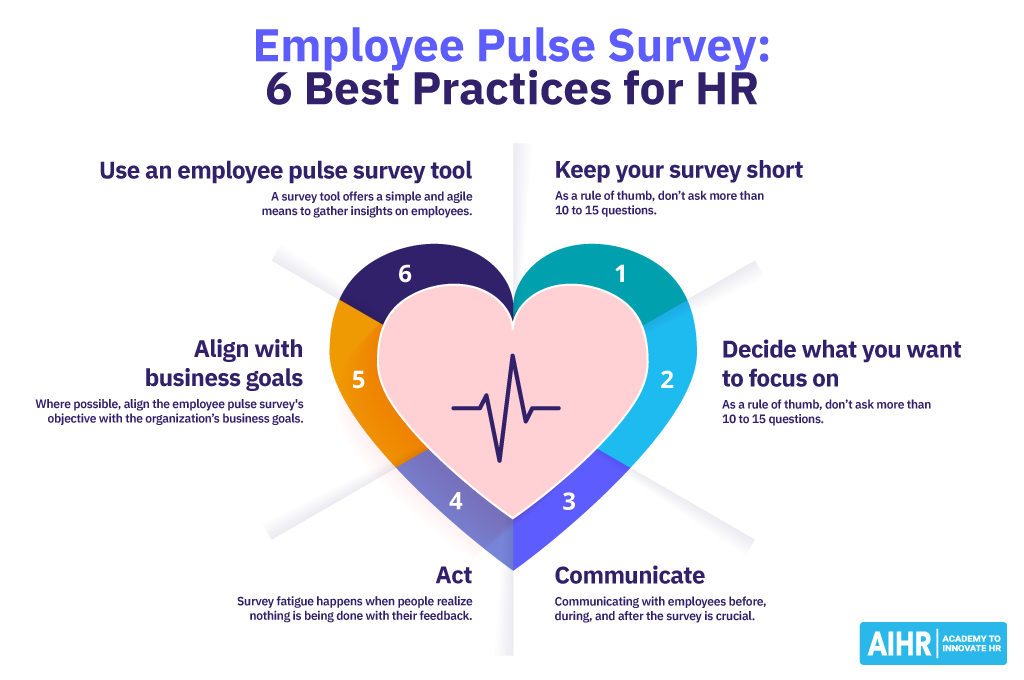
11 Employee pulse survey questions
We’ve discussed the importance of asking the right questions in your employee pulse survey, but what exactly do these look like?
In this section, we’ll share 11 example questions HR practitioners can ask employees in a pulse survey.
Overall engagement and satisfaction
| Question | 1 | 2 | 3 | 4 | 5 |
| 1. On a scale of 1 to 5, how happy are you with your job? | ⭘ | ⭘ | ⭘ | ⭘ | ⭘ |
| 2. On a scale of 1 to 5, how likely are you to recommend our company as a great place to work? | ⭘ | ⭘ | ⭘ | ⭘ | ⭘ |
Work experience
| Question | 1 | 2 | 3 | 4 | 5 |
| 3. On a scale of 1 to 5, how satisfied are you with the opportunities to learn and grow in your role? | ⭘ | ⭘ | ⭘ | ⭘ | ⭘ |
| 4. I feel comfortable sharing my opinion with my manager, even if it differs from their opinion. | ⭘ | ⭘ | ⭘ | ⭘ | ⭘ |
| 5. I feel that I belong among my peers and colleagues. | ⭘ | ⭘ | ⭘ | ⭘ | ⭘ |
| 6. I have all the resources I need to perform well and be successful in my role. | ⭘ | ⭘ | ⭘ | ⭘ | ⭘ |
Priorities and initiatives
| Question | 1 | 2 | 3 | 4 | 5 |
| 7. On a scale of 1 to 5, how satisfied are you with our recently issued generative AI policy for using ChatGPT at work? | ⭘ | ⭘ | ⭘ | ⭘ | ⭘ |
| 8. I know who or where to go with questions about our organization’s new generative AI policy. | ⭘ | ⭘ | ⭘ | ⭘ | ⭘ |
Previous survey
| Question | 1 | 2 | 3 | 4 | 5 |
| 9. I know where I can consult the employee pulse survey results from the survey that was held a month ago. | ⭘ | ⭘ | ⭘ | ⭘ | ⭘ |
| 10. On a scale of 1 to 5, how satisfied are you with the changes that have been made based on the results from our previous employee pulse survey? | ⭘ | ⭘ | ⭘ | ⭘ | ⭘ |
Digital suggestion box
| Question |
| 11. What ideas or suggestions do you have for us to make our company an even better place to work? |
Free employee pulse survey example
The template below provides a short, categorized list of questions that can be used for an employee pulse survey.
Questions can be tailored to any relevant topics you want to take your employees’ pulse on. Click on the button to download your free employee pulse survey template and customize it according to your specific needs.
Employee pulse survey tools
Popular employee pulse survey tools include (in alphabetical order):
A performance management and employee engagement platform that includes survey features
Weekly check-ins, pulse surveys, goal tracking.
Custom pricing
An employee engagement platform that helps the organization listen to employees through pulse surveys
Goal management, manager tools, culture and communication.
Custom pricing
A pulse survey tool focused on measuring engagement, satisfaction, and performance
Comprehensive benchmarking, text analytics, and heatmaps.
Custom pricing
A unified SaaS platform that helps companies create quick surveys to establish continuous employee communication.
Progress tracking, trend detection, analysis, and benchmarking.
Custom pricing
A free tool that can be used to create simple, online surveys with data automatically being collected in Google Sheets for analysis.
Customisable survey templates, charts with response data in real-time, available on any device.
Free and paid plans
An AI-powered survey platform offering various survey templates, customizable designs, and reporting tools
Pre-built templates, analytics, customizable surveys.
Free and paid plans
An online employee survey tool that lets you collect, measure, and act on real-time employee feedback
Track employee engagement, grasp the pulse, advanced survey analysis
Custom pricing
Key takeaway
When used correctly, an employee pulse survey can be a great tool to stay on top of employee sentiment regarding virtually any aspect of the organization and its functioning.


